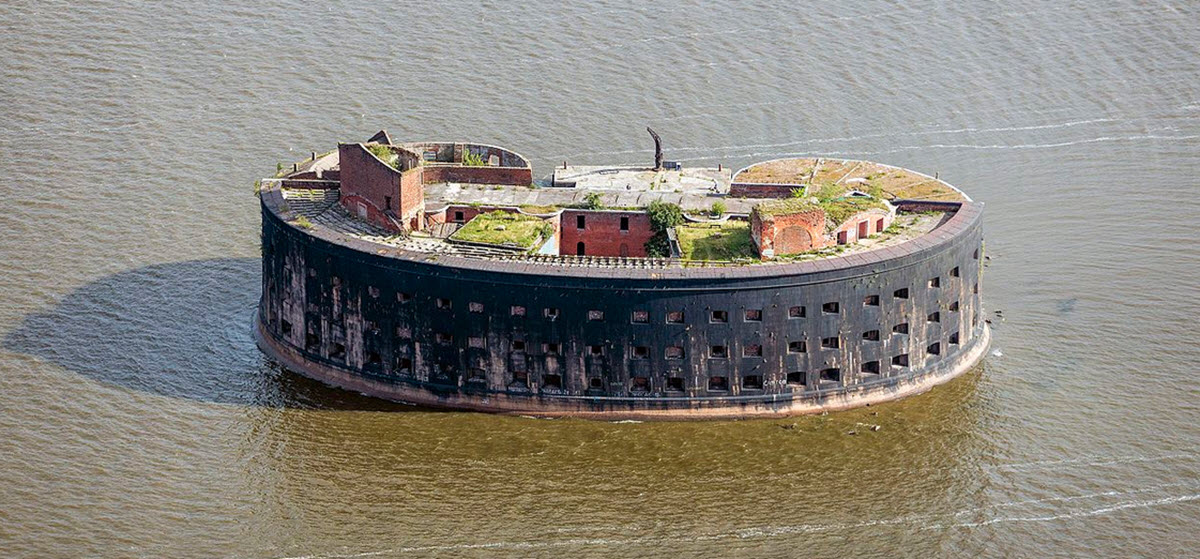Fort Alexander, also known as the Plague Fort, is a naval fortress on an artificial island near St. Petersburg. For a long time, it was off limits to the public – first because of its military significance and later because of the dangerous bacteriological research that was carried out here. Today, visitors are welcome, and boat tours to the fort are available.
Constructed on an artificial island, the Fort Alexander consist of an oval shaped building with three floors, a has yard in its centre. The fort’s design is similar to that of Fort Boyard (of TV gameshow fame) in France.
Fort Alexander was abandoned in the early 1980s, after a long period of simply being used as military storage. In the late 1990s and early 2000s, the desolated fort became a popular location for rave parties.
Since 2005, the fort has been managed by the conference centre Constantine Palace, who put an end to the illicit parties by securing the fort’s only gate.

Where is Fort Alexander?
Contents
Coordinates: 59.989586°N 29.717846°E
Fort Alexander is located on an artificial island in the Gulf of Finland, roughly 20 miles west of central St. Petersburg.
When was the fort built?
Fort Alexander was built in 1838-1845.
How was the fort built?
To secure the ground below the fort, builders had to drive 5,535 piles – each pile being 12 meter long – into the sea bed. The piles where then covered in sand, followed by a layer of concrete blocks and a layer of granite slabs. On top of this, the fort was built from bricks, and received granite face-work.
How large is Fort Alexander?
Fort Alexander is 90 meters by 60 meters, with over 5,000 square meters of total floor space and 103 cannon ports. There is also space on the roof intended for guns. Back in the day, Fort Alexander was considered suitable for a garrison of up to a thousand men.
Why was the fort built?
Fort Alexander was built to help guard the Baltic waterway to Saint Petersburg south of the naval base Kronstadt (on the island Kotlin). Fort Alexander was intended to work together with Fort Peter I, Fort Riskbank (Fort Pavel I), Fort Kronslot, and the coastal battery Fort Constantin.
As a window to the west, the port city St. Petersburg was of massive importance to the Russian Empire ever since it was created in the early 1700s. It was even the capital of Russia in 1713–1728 and 1732–1918. Because of this, several Russian rulers established forts and similar strongholds in and around the St. Petersburg area. In 1845, the ruling Emperor Nikolay I commissioned Fort Alexander, and named it after his brother Emperor Alexander I who had died in 1825.
Has Fort Alexander been directly involved in any war?
The fort never participated in any battles, but it played its role as a deterrent.
In the Crimean War of 1853-1856, it helped protect the Russian naval base Kronstadt against attempts made by British and French fleets. The Russian military placed galvanic naval mines and chemical-contact naval mines in the waters around Fort Alexander and other nearby fortifications, an this – in combination with the heavy fortifications – was sufficient to make an advancing British squadron turn around and go back in June 1854. Roughly a year later, an Anglo-French fleet under the command of Vice-Admiral Dundas made a new failed attempt.
Who designed the fort?
The initial drafts were made by Louis Barthelemy Carbonnier d’Arsit de Gragnac (also known as Lev Lvovich Carbonnier). When he died in 1836, Jean Antoine Maurice (also known as Moris Gugovich Destrem) took over the project.
The building of the fort was supervised by the Russian military engineer Mikhail von de Veide.
Why is Fort Alexander called the Plague Fort?
In 1896, Ford Alexander were struck from the Russian military register as it had become unsuitable for contemporary warfare. In January 1897, work on turning the fort into a bacteriological research laboratory was commenced, since the Russian Commission on the Prevention of Plague Disease had noticed how isolated it was. This was just a few years after the groundbreaking discovery that a bacillus (later named Yersinia pestis) was responsible for the much-feared bubonic plague, and the Russian imperial authorities wanted to put more effort into research about this and similar pathogens.
Fort Alexander was renovated in 1897-1899 to be more suitable as a research facility, and was fitted with research labs, containment labs, a stable for laboratory horses, and a cremation facility. A lot of the funding came from Duke Alexander Petrovich of Oldenburg, who was born and raised in St. Petersburg.
Finally, in August 1899, research work could start at the Plague Fort, under the auspices of the Imperial Institute of Experimental Medicine. After initially focusing on the study of plague and the preparation of serum and vaccines against it, the team eventually ventured into other fields as well – working to create treatments for diseases such as tetanus, typhus, cholera, and scarlatina.
The work was not without risk. There were three cases of plague among the staff in 1904 and 1907, which resulted in two deaths.
End of the Plague Fort
After the revolution in 1917, the research in the Plague Fort was closed down and research assets were moved to institutes in the city of St. Petersburg (now called Petrograd), Moscow and Saratov.
The Soviet Era
After the revolution, Fort Alexander was used as a storage and repair facility by the Russian Navy.
In the early 1980s, the fort was abandoned.
